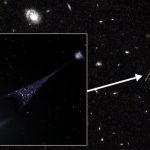Key Takeaways:
- Jupiter’s composition, rich in hydrogen and helium, also contains significant amounts of metals, offering valuable insights into its formation.
- Recent research suggests Jupiter’s metal content indicates a history of consuming rocky planetesimals during its early development.
- NASA’s Juno spacecraft, equipped with the Gravity Science instrument, provides crucial data on Jupiter’s internal dynamics, challenging previous assumptions.
- The presence of metals in Jupiter’s atmosphere implies accretion of larger planetesimals rather than just small pebbles during its formation.
- Insights from Jupiter’s study extend to understanding gaseous exoplanets, cautioning against relying solely on remote observations for determining their composition.
Jupiter is predominantly made up of hydrogen and helium, in quantities closely resembling those in the theoretical model of the early solar system. Additionally, it contains heavier elements, referred to as metals by astronomers. Despite being a small fraction of Jupiter’s composition, the presence and distribution of these metals provide valuable insights to astronomers.
A recent study suggests that Jupiter’s metal content and distribution indicate a history of consuming rocky planetesimals during its formative years.
Since the arrival of NASA’s Juno spacecraft at Jupiter in July 2016, our understanding of the planet’s formation and development has significantly evolved. Juno’s Gravity Science instrument, which communicates with Earth’s Deep Space Network, plays a pivotal role in this transformation. By measuring Jupiter’s gravitational field, researchers gain further insights into its composition.
Jupiter began its formation by accumulating rocky materials, followed by a phase of rapid gas accretion from the solar nebula. Over millions of years, it grew into the massive planet we know today. However, the method by which Jupiter initially gathered rocky materials remains a significant question. Did it accrete larger bodies like planetesimals, or did it gather smaller, pebble-sized material? The answer to this question would impact the timescale of Jupiter’s formation.
A study titled “Jupiter’s inhomogeneous envelope,” published in the journal Astronomy and Astrophysics, aimed to address this question. Led by Yamila Miguel, an Assistant Professor of Astrophysics at the Leiden Observatory & The Netherlands Institute for Space Research, the study investigates Jupiter’s internal dynamics.
While we often marvel at Jupiter’s surface features captured by JunoCam, such as its mesmerizing clouds and storms, these images only scratch the surface. The true secrets of Jupiter’s formation lie deep within its atmosphere, which extends tens of thousands of kilometers beneath its visible layer.
It is widely acknowledged that Jupiter is the oldest planet in the Solar System, yet the duration of its formation remains uncertain. By examining the metals present in Jupiter’s atmosphere using Juno’s Gravity Science experiment, researchers hope to unravel this mystery. Pebbles dispersed throughout Jupiter’s atmosphere play a crucial role in understanding its formation, and the Gravity Science experiment provides valuable data on their distribution. Prior to Juno, precise information on Jupiter’s gravity harmonics was lacking.

The study reveals that Jupiter’s atmosphere is more complex than previously thought, with a higher concentration of metals towards the planet’s core. The total mass of metals within Jupiter ranges from 11 to 30 times that of Earth.
With the data collected, the research team constructed models to explore Jupiter’s internal structure. These models, categorized into 3-layer and dilute core models, shed light on the planet’s formation process.

Lead author Miguel explains, “Gas giants like Jupiter acquire metals during formation through two mechanisms: the accretion of small pebbles or larger planetesimals.” The abundance of metals within Jupiter suggests that it likely accreted planetesimals, as pebbles alone would not account for such richness.
Furthermore, the study indicates a lack of convection in Jupiter’s deep atmosphere, contrary to previous assumptions. This finding challenges the notion of Jupiter being completely mixed through convection.
The implications of this research extend beyond Jupiter, providing insights into the study of gaseous exoplanets and their metallicity. The authors suggest that metallicities inferred from remote observations may not accurately represent the bulk metallicity of exoplanets.
The arrival of the James Webb Space Telescope promises further discoveries in the study of exoplanet atmospheres. However, as demonstrated by this research, understanding the composition of giant gas planets requires deeper exploration beyond surface observations.


